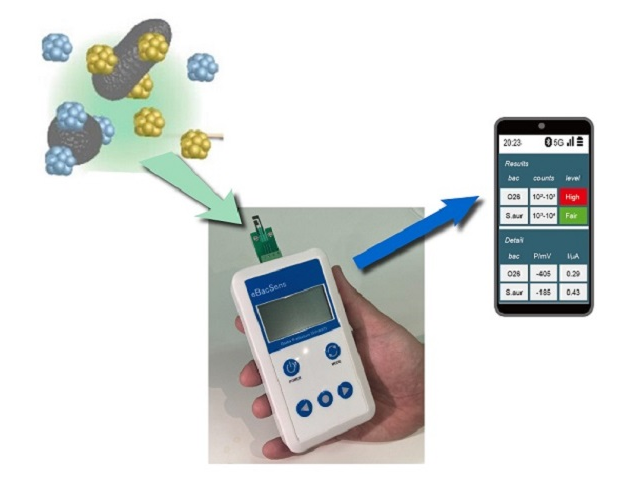Research News
Apr 5, 2024
- Engineering
Rapid, simultaneous detection of multiple bacteria achieved with handheld sensor
Disease-causing E. coli among species labeled electrochemically using organic metallic nanohybrids
Marking bacteria electrochemically for rapid detection
From left: Image of bacteria labeled with electrochemical markers, an electrochemical instrument to measure the data, and an image of the data displayed on a smartphone.
Credit: Hiroshi Shiigi, Osaka Metropolitan University

Hear the words E. coli or salmonella and food poisoning comes to mind. Rapid detection of such bacteria is crucial in preventing outbreaks of foodborne illness. While the usual practice is to take food samples to a laboratory to see the type and quantity of bacteria that forms in a petri dish over a span of days, an Osaka Metropolitan University research team has created a handheld device for quick on-site detection.
Led by Professor Hiroshi Shiigi of the Graduate School of Engineering, the team experimented with a biosensor that can simultaneously detect multiple disease-causing bacterial species within an hour.
“The palm-sized device for detection can be linked to a smartphone app to easily check bacterial contamination levels,” Professor Shiigi explained.
His team synthesized organic metallic nanohybrids of gold and copper that do not interfere with each other, so that electrochemical signals can be distinguished on the same screen-printed electrode chip of the biosensor. These organic−inorganic hybrids are made up of conductive polymers and metal nanoparticles. The antibody for the specific target bacteria was then introduced into these nanohybrids to serve as electrochemical labels.
Results confirmed that the synthesized nanohybrids functioned as efficient electrochemical labels, enabling the simultaneous detection and quantification of multiple bacteria in less than an hour.
“This technique enables rapid determination of the presence or absence of harmful bacteria prior to shipment of food and pharmaceutical products, thereby helping to quickly ensure safety at the manufacturing site,” Professor Shiigi said.
The team aims to develop new organic metallic nanohybrids to simultaneously detect even more bacterial species.
The findings were published in Analytical Chemistry.
Funding
This study was financially supported by a JST START grant (no. JPMJST1916). We also gratefully acknowledge the financial support provided by the Japan Society for the Promotion of Science Grant-in-Aid for Scientific Research (A) (Kakenhi grant no. 21H04963) and Grants-in-Aid for Challenging Exploratory Research (grant no. 22K18442). Satohiro Itagaki was financially supported by JST, the establishment of university fellowships toward the creation of science technology innovation (grant no. JPMJFS2138).
Paper Information
Journal: Analytical Chemistry
Title: Simultaneous Electrochemical Detection of Multiple Bacterial Species Using Metal-Organic Nanohybrids
DOI: 10.1021/acs.analchem.3c04587
Authors: Satohiro Itagaki, Akihiro Nakao, Shogo Nakamura, Masashi Fujita, Shigeki Nishii, Yojiro Yamamoto, Yasuhiro Sadanaga, and Hiroshi Shiigi
Published: 3 February 2024
URL: https://doi.org/10.1021/acs.analchem.3c04587
Contact
Hiroshi Shiigi
Graduate School of Engineering
Email: shii[at]omu.ac.jp
*Please change [at] to @.
SDGs
